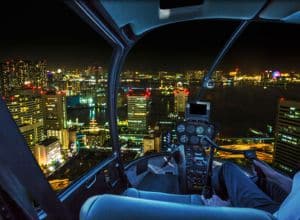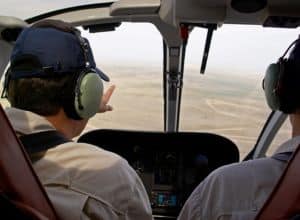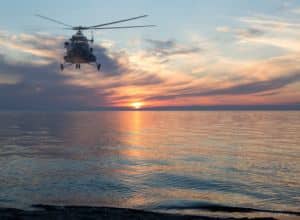Night vision goggles for helicopter pilots have grown in importance in the aviation sector, giving pilots better visibility during nighttime operations. These gadgets have made major advances to flight safety and performance, especially in difficult conditions like low visibility or bad weather. We will explore the history of night vision technology, its applications in aviation, the numerous types of NVGs available, their benefits and limits, as well as the regulatory concerns for their usage in this comprehensive post.
The Evolution of Night Vision Technology
Night vision technology was developed during World War II when there was a need for better vision skills to obtain a strategic advantage over the adversary. Image intensification technology, which amplifies available light to generate a visible image, was employed in early gadgets. Night vision technology has progressed throughout the years, with each iteration bringing increases in performance, sensitivity, and resolution.
Aviation Applications
Night vision equipment is widely used in both military and civilian aviation. For decades, military pilots have used night vision goggles to increase their situational awareness and navigation during nighttime operations. Civil aviation has also adopted the technology, with uses including law enforcement, search and rescue, emergency medical services, and firefighting.
Night Vision Goggle Types

Night vision technology in aviation is classified into three types: image intensification, thermal imaging, and light amplification by stimulated emission of radiation (LASER) systems.
Image Enhancement
The most widely employed technique in aviation NVGs is image intensification. These gadgets create a visible image by amplifying ambient light, such as moonlight or starlight. A photocathode is commonly used in image intensification NVGs to convert photons into electrons, which are subsequently amplified and projected onto a phosphor screen to form a visible image. Image intensification NVGs of the latest generation have improved resolution and sensitivity, making them appropriate for a wide range of aviation applications.
Thermographic Imaging
Thermal imaging NVGs detect and transform infrared (IR) radiation generated by objects into a visual image. Because it relies on temperature variations rather than light, this technique is especially suitable in environments with little or no ambient light. However, due to their poor capacity to detect fine details and distinguish between objects at identical temperatures, thermal imaging NVGs are often less successful in aviation applications.
LASER Techniques
LASER-based NVGs generate a visible image by emitting a low-power infrared laser beam that is reflected off objects and detected by a sensor. These systems are perfect for long-range detection and identification due to their outstanding detail and resolution. However, their exorbitant cost and scarcity have confined their use to purely military applications.
NVG Generations
Night vision goggles (NVGs) have gone through several generations, with each delivering advances in performance, sensitivity, and resolution. The NVG generations are divided as follows:
0 Generation: 0 Generation NVGs were created during WWII and used active infrared (IR) technology. These devices used an infrared illuminator to emit infrared light that bounced off objects and was detected by the NVG. While these devices provided some nighttime visibility, they had a number of disadvantages, including low image quality, a short range, and the possibility of being detected by enemy troops employing comparable equipment.
Generation 1: The first generation of NVGs appeared in the 1960s and featured passive image intensification technology. They relied on ambient light to form a visible image, such as moonlight or starlight. Photons were converted into electrons by a photocathode, which were then accelerated through an electric field and displayed on a phosphor screen. Although Gen 1 NVGs performed better than Gen 0 devices, they still had limited range and image quality.
Generation 2: Debuting in the 1970s, second-generation NVGs exhibited considerable advances in image quality and sensitivity thanks to the addition of a microchannel plate (MCP). The MCP is an electron multiplier that amplifies the signal greatly, resulting in a brighter, clearer image with higher resolution. In addition, when compared to Gen 1 devices, Gen 2 NVGs had a longer battery life and performed better in low-light circumstances.
Generation 3: Developed in the 1980s, third-generation NVGs are now the most extensively utilized equipment in military and civilian aircraft applications. These devices make use of a gallium arsenide (GaAs) photocathode, which has higher sensitivity in the near-infrared region and hence performs better in low-light conditions. A filmless MCP is also included in Gen 3 NVGs, which minimizes image noise and improves resolution and clarity. These devices outperform previous versions in terms of performance, image quality, and range.
Generation 4: These NVGs claim to outperform Gen 3 devices in terms of performance, thanks to advances such as auto-gating, which helps to reduce visual distortion and blooming produced by bright light sources. Other improvements include greater sensitivity, improved resolution, and reduced image noise.
The Advantages of Night Vision Goggles in Aviation
The use of night vision goggles for helicopter pilots has various advantages, including greater situational awareness, safety, and operational capability.

Better Situational Awareness
During nighttime missions, NVGs provide pilots with a clearer view of their surroundings, allowing them to see hazards, terrain, and other aircraft more quickly. This increased situational awareness has the potential to greatly reduce the probability of accidents and improve overall flight safety.
Increased Security
Night vision goggles for helicopter pilots can help avoid collisions with obstructions, terrain, or other aircraft by offering a more comprehensive picture of the environment, especially during key phases of flight such as takeoff and landing. This increased safety is crucial for activities in isolated or difficult environments, such as hilly terrain or areas with minimal infrastructure.
Expanded Operational Capabilities
NVGs enable pilots to operate more successfully at night, boosting the overall operational capability of aviation assets. This is especially useful for emergency services like search and rescue or medical evacuation, where a quick response can make or break a mission’s outcome. Furthermore, NVGs can help pilots navigate difficult weather circumstances, like fog or low clouds, where visual references are restricted.
Night Vision Goggles’ Limitations in Aviation
While night vision goggles for helicopter pilots have numerous advantages, they do have some restrictions that pilots should be aware of when utilizing them during flight operations.
Field of View Is Limited
Night vision goggles for helicopter pilots often have a narrower field of view (FOV) than the human eye, which can cause tunnel vision. This narrower field of view can make it difficult for pilots to retain situational awareness, especially when maneuvering or watching many things simultaneously.
Depth Perception and Distortion
NVG images can be skewed or have a “fish-eye” look, making it difficult to effectively gauge distances and relative locations. Furthermore, because NVGs do not provide genuine depth vision, estimating distances between objects can be difficult.
Color Perception Has Been Reduced
Night vision goggles for helicopter pilots frequently generate monochromatic images, making it difficult for pilots to discriminate between hues or identify things depending on their color. When attempting to recognize airplane navigation lights, runway lights, or other color-coded visual cues, this diminished color perception might be very difficult.
Regulatory Considerations for Aviation Night Vision Goggles
Because of the possible safety issues connected with the use of NVGs in both military and civilian applications, aviation regulatory authorities have created standards and requirements for their use in both military and civilian applications.
Certification and Training

Pilots who want to use NVGs in flight must go through particular training and certification to guarantee they are adept in their use and aware of their limits. This training normally involves both classroom instruction and hands-on in-flight practice with NVGs.
Inspection and Maintenance
NVGs must be maintained and inspected on a regular basis to ensure their continued safe and effective operation. Maintenance and inspection of night vision goggles for helicopter pilots are frequently required by aviation regulatory agencies, which may involve periodic tests of picture quality, alignment, and overall function.
Limitations in Operations
Aviation regulatory organizations in some jurisdictions may put operational constraints on the use of night vision goggles for helicopter pilots, such as restricting their usage to specific types of aircraft, operations, or weather situations. These restrictions are intended to reduce the dangers connected with NVG use while also ensuring aircraft safety.
Conclusion
Night vision goggles for helicopter pilots have become an indispensable instrument in the aviation sector, providing considerable benefits in terms of improved situational awareness, safety, and operating capability. To ensure their safe and successful use, pilots must be aware of the limitations of NVG technology and adhere to established regulatory criteria. We should expect more increases in NVG performance as technology advances, making them an even more important aspect of aircraft operations in the coming years.
As technology advances, it is critical for the aviation sector to adapt and embrace advances in night vision goggles. This includes implementing updated training programs and ensuring that pilots are well-equipped to deal with the problems of NVG use. Regulatory agencies will also need to stay current on new technologies in order to provide suitable recommendations and regulations for NVG use in diverse aviation applications.

